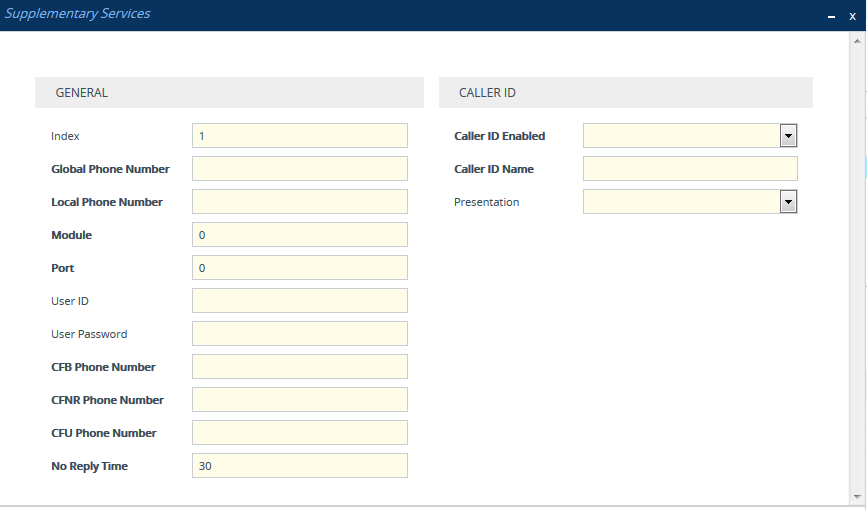Configuring Multi-Line Extensions and Supplementary Services
The Supplementary Services table lets you configure up to 100 supplementary services for endpoints connected to the device.
The feature is applicable only to FXS interfaces.
You can use the table for the following functionality:
| ■ | Configuring multiple phone line extension numbers per port, supporting point-to-multipoint configuration of several phone numbers per channel. |
| ■ | Registration of each line extension (endpoint), using a user-defined user ID and password, to a third-party softswitch for authentication and/or billing. For each line extension, the device sends a SIP REGISTER to the softswitch, using the global number in the From/To headers. If authentication is necessary for registration, the device sends the endpoint’s user ID and password in the SIP MD5 Authorization header. For viewing registration status, see Viewing Registration Status. |
| ■ | Caller ID name per line extension, which is displayed to the called party (if enabled). |
| ■ | Enabling receipt by the line extension of caller ID from incoming calls. |
| ■ | Routing IP-to-Tel calls (including voice and fax) to specific endpoints based on called line extension number (local number). To enable this functionality, in the Trunk Group Settings table, set the 'Channel Select Mode' field to Select Trunk by Supplementary Services Table for the Trunk Group to which the port belongs (see Configuring Trunk Group Settings). |
| ■ | Mapping local numbers (line extension number) with global phone numbers (E.164). The endpoint can be configured with two numbers – local and global. The local number represents the endpoint’s line extension number (e.g., PBX extension number); the global number represents the corresponding E.164 number used for the IP side in the SIP message: |
| ● | IP-to-Tel calls: Maps the called global number in the user part of the SIP Request-URI in the incoming SIP message to the local number sent to the Tel side. For example, the device receives an incoming IP call with a destination (called) that is a global number 638002 and then sends the call to the Tel side with the destination number manipulated to the corresponding local number of 402. |
| ● | Tel-to-IP Calls: Maps the calling (source) local number of the Tel side to the global number sent to the IP side (in the From and To headers of the outgoing SIP message). For example, if the device receives a Tel call from line extension local number 402, it changes this calling number to 638002 and then sends the call to the IP side with this calling number. This functionality in effect, validates the calling number. |
| ● | If you have configured regular Tel-to-IP or IP-to-Tel manipulation rules (see Configuring Source/Destination Number Manipulation), the device applies them before applying the local-global mapping rules configured in the table. |
The following procedure describes how to configure the Supplementary Services table through the Web interface. You can also configure it through ini file [ISDNSuppServ] or CLI (configure voip > gateway digital isdn-supp-serv).
| ➢ | To configure endpoint supplementary services: |
| 1. | Open the Supplementary Services table (Setup menu > Signaling & Media tab > Gateway folder > DTMF & Supplementary > Supplementary Services). |
| 2. | Click New; the following dialog box appears: |

| 3. | Configure a supplementary service according to the parameters described in the table below. |
| 4. | Click Apply. |
The figure below displays an example of multiple-line extensions configured in the Supplementary Services table:

You can also register and un-register an endpoint configured in the table:
| ➢ | To register or un-register an endpoint: |
| 1. | In the Trunk Group Settings table (see Configuring Trunk Group Settings), configure the registration method using the 'Registration Mode' parameter. |
| 2. | In the Supplementary Services table, select the required endpoint. |
| 3. | From the 'Action' drop-down list, select Register. To unregister the endpoint, select Un-Register. |
Supplementary Services Table Parameter Description
|
Parameter |
Description |
|||||||||
|---|---|---|---|---|---|---|---|---|---|---|
| General | ||||||||||
|
'Index' [Index] |
Defines an index number for the new table row. Note: Each row must be configured with a unique index. |
|||||||||
|
'Global Phone Number' phone-number [PhoneNumber] |
Defines a global telephone extension number for the endpoint. The global number is used for the following functionality:
|
|||||||||
|
'Local Phone Number' local-phone-number [LocalPhoneNumber] |
Defines a local telephone extension number for the endpoint (e.g., the PBX extension number). The local number is used for the following functionality:
|
|||||||||
|
'Module' module [Module] |
Defines the device's module number to which the endpoint is connected. |
|||||||||
|
'Port' port [Port] |
Defines the port number on the module to which the endpoint is connected. |
|||||||||
|
'User ID' user-id [UserId] |
Defines the User ID for registering the endpoint to a third-party softswitch for authentication and/or billing. The valid value is a string of up to 60 characters. By default, no value is defined. |
|||||||||
|
'User Password' user-password [UserPassword] |
Defines the user password for registering the endpoint to a third-party softswitch for authentication and/or billing. Note:
|
|||||||||
|
Caller ID |
||||||||||
|
'Caller ID Enabled' caller-id-enable [IsCallerIDEnabled] |
Enables the receipt of Caller ID.
|
|||||||||
|
'Caller ID Name' caller-id-number [CallerID] |
Defines the caller ID name of the endpoint (sent to the IP side). The valid value is a string of up to 18 characters. |
|||||||||
|
'Presentation' presentation-restricted [IsPresentationRestricted] |
Defines if the endpoint sends its Caller ID information to the IP when a call is made.
|
|||||||||